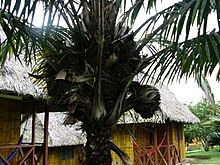| Phytelephas | |
|---|---|

| |
| Fruiting tagua palm (Phytelephas aequatorialis) | |
| Scientific classification | |
| Kingdom: | Plantae |
| Clade: | Tracheophytes |
| Clade: | Angiosperms |
| Clade: | Monocots |
| Clade: | Commelinids |
| Order: | Arecales |
| Family: | Arecaceae |
| Subfamily: | Ceroxyloideae |
| Tribe: | Phytelepheae |
| Genus: | Phytelephas Ruiz & Pav. |
| Species[1] | |
| Synonyms[2] | |
Phytelephas is a genus containing six known species of dioecious[3] palms (family Arecaceae), occurring from southern Panama along the Andes to Ecuador, Bolivia, Colombia, northwestern Brazil, and Peru.[2][4] They are commonly known as ivory palms, ivory-nut palms or tagua palms (/ˈtɑːɡwə, ˈtæɡ-/); the scientific name Phytelephas means "plant ivory" or more literally, "plant elephant". This and the first two of the common names refer to the very hard white endosperm of their seeds (tagua nuts or jarina seeds), which resembles elephant ivory.[5][6]
- ^ The Plant List (2013). Version 1.1. Published on the Internet; http://www.theplantlist.org/tpl1.1/search?q=Phytelephas (accessed 11 September 2017).
- ^ a b "World Checklist of Selected Plant Families: Royal Botanic Gardens, Kew". kew.org.
- ^ Pülschen, L. (2000). "Biology and Use of Vegetable Ivory Palms (Phytelephas SPP.)". Acta Horticulturae (531): 219–222. doi:10.17660/ActaHortic.2000.531.35.
- ^ Govaerts, R. & Dransfield, J. (2005). World Checklist of Palms: 1-223. The Board of Trustees of the Royal Botanic Gardens, Kew.
- ^ Vegetable ivory: saving elephants and the rain forest
- ^ Bolongaro, Kait (2017-03-23). "How an obscure seed is helping to save the elephant". BBC News. Retrieved 2017-03-27.